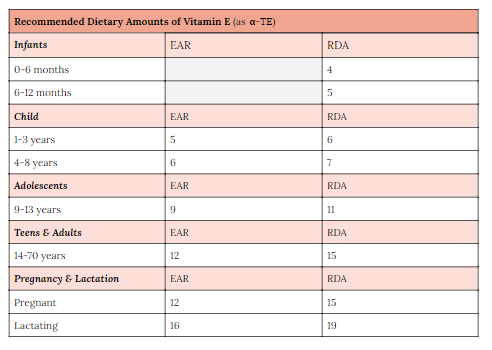Vitamin E
- Anni Weeks, NDTR
- Aug 18, 2020
- 6 min read

What is vitamin E?
Vitamin E is a fat-soluble vitamin (click here learn more about the difference between fat and water soluble vitamins). This vitamin is also often called by another name-- tocopherol. Here are some forms of vitamin E you may have read about elsewhere:

The main difference between tocotrienols and tocopherols is that the tocopherols are more biologically active, meaning the substance acts with more of a potent positive effect on living things than its counterpart (tocotrienols) does.
Like other fat-soluble vitamins, vitamin E depends on being ingested with sources of fat (click here for a healthy fat foods reference card) to be optimally digested and absorbed.
Relationships with other nutrients
The water soluble vitamin C performs some actions that complement the functions of vitamin E. Selenium, a mineral (learn the basics about minerals by clicking here), is also related to vitamin E. This vitamin (E) and mineral (selenium) work together to complement one another by performing functions necessary for metabolism as well as protecting the body from injury and inflammation.

What does the body use Vitamin E for?
Vitamin E functions as a strong antioxidant, which means it helps to prevent or slow damage to cells, intestines, and body tissues. The body also uses this vitamin to help protect cell membranes, which is often why you see Vitamin E as an added ingredient in moisturizers for skin and scalp products. While these products may have marginal benefits, the best intake method is generally through the diet. In a later section, I’ll list some foods you can add to your diet to up your intake levels of this vitamin.
Since it aids in membrane protection and anti-oxidation efforts, vitamin E is also helpful in keeping your skin and hair looking youthful. It’s even considered an “anti-aging” agent in many serums and creams. Vitamin E also has a protective effect on red blood cells. Additionally, vitamin E aids in maintaining and protecting body tissues from injury and inflammation. If that wasn’t enough to convince you that this vitamin is excellent, there’s even research showing that vitamin E is involved in cell signaling and gene expression.
Dietary Reference Intakes (DRIs) for Vitamin E

The need for vitamin E is partly dependent upon the amount of poly-unsaturated fatty acids or PUFAs consumed. PUFAs are a class of fatty acids that include important essential compounds that the body can’t produce on its own. Omega-3 is one example of a PUFA. In other words, this relationship between vitamin E and dietary PUFAs exists because the requirement for vitamin E increases or decreases as the degree of unsaturated fatty acids in body tissues rises or falls. The good news is that good sources of PUFAs also tend to be adequate sources of vitamin E.
Adequate Intake (AI): recommended daily intake of a nutrient; established by the IOM to meet or to exceed the needed amount to maintain adequate nutrition for most people in a particular stage of life or gender group; established when not enough evidence is available to determine the RDA
Estimated Average Requirement (EAR): computed using an allowance for adequate liver stores; children and adolescent requirements are adjusted using metabolic body weight
Recommended Dietary Allowance (RDA): covers the needs of 97-98% of individuals in a group; the average amount of a nutrient a healthy person should consume daily. Vary by gender, age, and whether a woman is pregnant or breastfeeding. Developed by the Food and Nutrition Board at the Institute of Medicine (IOM) of the National Academies.
𝝰-TE: alpha-tocopherol equivalents
IU: International units; in this case an outdated form of measurement for this vitamin but still sometimes found on labels. Consult your dietitian or other accredited health care professional for proper conversion of IU to 𝝰-TE units.

Deficiency
Symptoms of deficiency vary greatly.
Generally, symptoms of a lack of vitamin E can be organized into the following categories:
Neuromuscular
Vascular
Reproductive systems
Symptoms of deficiency
In the case of vitamin E, deficiency symptoms can take years to develop. Deficiency is rare, and cases are most commonly found among those who have fat malabsorption disorders or diseases (i.e. biliary atresia, exocrine pancreatic insufficiency, lipid transport abnormalities). Symptoms of deficiency of vitamin E include the following:
Loss of deep tendon reflexes
Impaired sensation
Changes in balance
Changes in coordination
Muscle weakness
Visual disturbance
It is common for newborn infants to have low tissue concentrations of vitamin E. However, this may put them at risk for deficiency and should be monitored regularly.

Toxicity
Research has shown that vitamin E is one of the least toxic vitamins, and that humans are usually able to tolerate relatively high intakes (although this level of intake is not recommended). However, mild gastrointestinal (GI) problems can occur with intakes between 200 and 800 mg.
Upper Limit (UL): also known as the Tolerable upper intake level; largest daily intake of a nutrient that is considered safe for most people; exceeding this limit is not recommended and may cause harm to the body; Set by the Food and Nutrition Board at the National Academies of Sciences, Engineering, and Medicine.

In recent years, toxicity of vitamin E has been noted in human subjects, but results have been varied. The most serious adverse effects have been evidenced in animals, and due to the difficulties of human nutrition studies, it’s often unethical (and thankfully so) to conduct the studies that would definitively show the negative effects of a vitamin E overdose. One thing is certain among scientists, however-- it’s best for now to stay within the recommended limits.
Symptoms of toxicity
Symptoms of toxic levels of vitamin E can include the following:

Increased bleeding
GI distress
Nausea
Diarrhea
Flatulence
Possible increased severity of respiratory infections
Possible muscle weakness, fatigue, and double vision
In cases of vitamin E intake where intake is high, vitamin E can interfere with the metabolism of other fat-soluble vitamins (A,D,or K). It may increase bleeding risk secondary to interfering with vitamin K, which has a crucial role in blood clotting. Additionally, due the interrelated nature of the mineral selenium and vitamin E, high concentrations of vitamin E may reduce the effect of selenium if concentrations of selenium are lower and the concentration of vitamin E is higher.
How to test your levels of Vitamin E
These tests should be run under direct medical supervision. Ask your doctor and dietitian for more information.
Primary method: blood analyses (i.e. plasma concentrations)
Crude estimate: erythrocyte hemolysis test (>20% indicating deficiency); generally associated with plasma 𝝰-tocopherol concentrations below 5 mg/L
Microscopic imaging for injury and necrosis at the cellular level
Sources
The substances that make up vitamin E are only produced in plants, with plant oils being the optimal source. Salad oils, margarine, and shortenings make up the most common sources of consumption among Americans according to researchers.

Nuts tend to be a great source of vitamin E, including compounds and other vitamins as well that help to protect against deteriorating cognitive function.
How stable is Vitamin E?
Vitamin E is fairly stable but can be destroyed by being exposed to air for extended periods of time depending upon the form it takes. Luckily, vitamin E is not lost by cooking but can be destroyed during deep frying methods.
Supplementation & Treatment with Vitamin E
Absorption of vitamin E varies dramatically according to research, so individualized approaches when it comes to nutritional therapy and vitamin supplementation are suggested. As mentioned previously, although cosmetic products may contain some small amounts of this vitamin, oral intake (through the diet) is recommended and research has shown this is the most effective method of intake for consumption of this nutrient by the body.
Note: Synthetic forms of vitamin E may be listed on supplement labels as “DL-” or “dl-𝝰-tocopherol”.
FREE Patient Resources
Related Professional Resources

Don't you wish you had a quick reference to brush up on vitamin E before seeing your clients or patients? This quick reference will help you organize your thoughts and prove to be a great resource in between appointments. Upon purchase, a high quality pdf file will be available for download. From there, you can turn the file into a print-out, poster, or whatever you would like!
Related Prints
Visit the Print Store for digital downloads and much more!
Related Posts
References
Mahan KL, Raymond JL. Krause's Food & the Nutrition Care Process 13th Edition. 2011. Saunders. ISBN: 978-1437722338.
Hart J. Eat Pretty. Chronicle Books. 2014. ISBN 978-1452123660.
Gropper SS, Smith JL, Carr TP. Advanced Nutrition and Human Metabolism, Seventh Edition. Cengage Learning. 2017. ISBN: 978-1305627857. \
Food and Nutrition Board, Institute of Medicine, National Academies. Dietary Reference Intakes (DRIs): Recommended Dietary Allowances and Adequate Intakes, Vitamins. Accessed at https://www.ncbi.nlm.nih.gov/books/NBK56068/table/summarytables.t2/?report=objectonly.
Freston K, Friedrich B. Clean Protein (The Revolution that will Reshape Your Body, Boost Your Energy--and Save our Planet). Hachette Books. 2018. ISBN: 978-1-60286-332-3.














































Comments